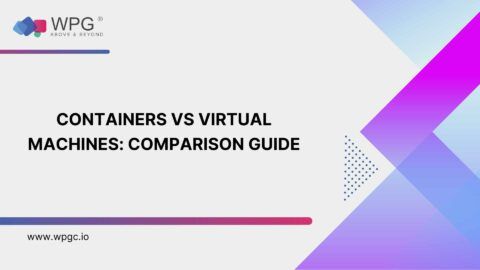Developers often debate using containers or virtual machines (VMs) to host cloud applications. This article clearly explains the key differences in plain language. It covers major evaluation criteria. It makes the two approaches easy to grasp for informed decision making.
Table of Contents
What Are Containers?
Containers package together just the files an application requires to run. They include libraries, settings, dependencies, and more, and are a standardized building block. This containment provides portability by bundling necessary runtime elements.
Think of it as storing application ingredients in a shipping container. This makes transportation smooth. This allows for reliable migration across environments. It includes on-premise data centers and major cloud platforms. It minimizes compatibility disruptions during transitions.
Additional container benefits include:
- Fast Startup Times – Containers can launch rapidly. They isolate applications outside slower booting operating systems. This enables quicker transitions between computing environments.
- Efficient Infrastructure Use: Using containers is efficient infrastructure use because they conserve server resources. They do this by running more application instances per host. They achieve this by using shared operating system kernels. This is instead of separate VM operating system silos. This facilitates higher density.
- Flexibility: The contained application building blocks can scale up and down. They adjust computing resources dynamically. This shows their flexibility. They do this to meet changing performance demands. Rapid iteration.
The downsides center on orchestration complexity. It’s to manage large container fleets. Windows support is immature compared to Linux. There’s less visibility vs VMs. But overall an excellent approach for cloud-native applications focusing on portability.
What Are Virtual Machines?
Unlike containers holding applications alone, virtual machines take conceptual encapsulation further. VMs run an entire simulated guest operating system. This includes virtualized CPU, memory, storage, networking, operating system, and more.
This provides a neatly bundled package appearing just like a real server. The virtual OS boots up and functions identically as a physical device. The underlying host efficiently manages and supplies hardware resources on-demand as workloads change.
Standout VM capabilities:

- Strong Workload Isolation – Reinforces security by completely separating workloads using hardware virtualization. This enables greater partitioning options between app groups.
- Infrastructure Control – Fine tune virtual hardware subsystems and OS monitoring to customize full environments. Tweak based on audience needs.
- Broad Compatibility – Support running applications requiring specific operating system versions, libraries, or architectures – especially useful for legacy apps.
Downsides are mostly around scalability complexity and somewhat limited agility depending on implementation. Overall, an excellent approach for modeled stability, security, and mimicking standalone on-premise servers.
Comparing Key Decision Metrics
Application Factors
- Monolithic vs microservices – Microservices suit container portability around APIs. Monoliths align to VM OS foundations.
- Stateful vs stateless – Stateless apps sync well with container transport anywhere. Stateful may need VM locality.
- Required languages/frameworks – Containers underpin certain languages while VMs offer flexibility.
This signals what environment makes the most sense.
Team Considerations
- Automation comfort – Orchestration across containers demands this. VMs have more familiarity.
- DevOps openness – Container deployment velocity builds on Iterative culture.
Assesses organizational readiness for container demands.
Security & Compliance Factors
- Data types handled – VMs isolate sensitive data more comprehensively.
- Needed isolation extent – VMs provide hardened app boundaries ideal for compliance.
Evaluate information security needs.
Infrastructure Resource Priorities
- Desired app density per host – Containers excel through lightweight sharing.
- Target performance characteristics – Profile container and VM options.
There are clear infrastructure implications.
Good Use Case Examples
Containers suit:
- Microservices – Fast iteration around portable APIs.
- Cloud native CI/CD – Optimized pipelines.
- Web apps – Quick scalability when stateless.
- Cross-platform needs – Migration across environments.
Virtual Machines suit:
- Legacy monoliths – Harder to decompose apps.
- OS dependent apps – Underpinning integration.
- Stateful apps – Long running consistency.
- Compliance needs – Security in depth.
Conclusion
Start by understanding the differences in isolation approaches when choosing containers or VMs. Consider the use cases each excels at. Also consider security considerations, efficiency goals, and integration needs. Technology leaders can use insight into these dynamics to pick ideal application platforms. They should align these platforms to business priorities across modern or legacy apps.
FAQs
Containers excel at portable microservices. They also benefit cloud-native apps through rapid iteration. Stateless web apps need scalability. VMs are suitable for monolithic apps, legacy software, and stateful data-intensive apps. They are also suitable when total isolation is required.
Legacy monoliths prove challenging for containerization without refactoring first. Retooling grants portability, while still maintaining VMs suits these apps well today. Strategies like lifting and shifting VM workloads prevent change requirements.
Linux containers have broader functionality and compatibility vs Windows options still emerging. But Windows containers make progress with native support in latest OS versions. Evaluate tradeoffs – a mix of Linux and Windows often makes sense.
Analyze application architectures, security needs, efficiency goals, integration requirements and organizational skills. Weigh pros and cons for each solution. The right size choices are based on workload types. Often, a combination works best instead of an either/or binary choice.

